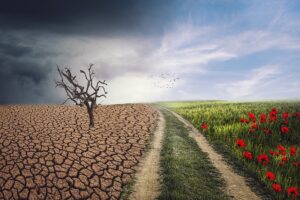As you walk outside and feel the familiar pattern of raindrops on your skin, you likely don’t give much thought to the fascinating properties of rain. However, rain is a remarkable part of our natural world that holds many secrets. The rain that falls from the sky and sustains all life on earth is the result of an incredible journey. Rain undergoes a series of changes and follows certain patterns from its initial formation high up in the clouds to its descent towards the ground, which aren’t obvious when you’re caught without an umbrella. The next time rain surprises you with its arrival, surprise yourself with these 10 facts about the mysterious phenomenon of rain. A deeper understanding of rain will give you a profound appreciation for this life-giving force of nature.

Raindrops Are Not Actually Teardrop-Shaped
As surprising as it may seem, raindrops are not actually tear-shaped. While falling through the air, raindrops flatten into oblate spheroids due to air resistance. They only appear rounded when viewed from the side.
The size of raindrops varies depending on several factors, including humidity, temperature, and updraft speeds. On average, raindrops measure 1 to 6 millimeters in diameter. However, some raindrops can reach up to 8 millimeters, almost the size of a small marble. The larger the raindrop, the faster it falls due to increased mass. At their terminal velocity, even the largest raindrops do not drop fast enough to cause damage.
The number of raindrops that fall in a single storm is staggering. A one-inch rainstorm deposits around 6 million gallons of water over an acre of land. Since the average raindrop has a volume of 0.05 milliliters, that amounts to 120 billion raindrops in a single acre.
While rain may seem commonplace, its role in the water cycle and climate is crucial. Rain transports water through evaporation and condensation, sustaining life as we know it. The water in raindrops recycles endlessly between the land, oceans, atmosphere, and all living things.
Though simple in form, rain contains hidden depths of complexity that continue to surprise and inspire wonder in those who study the workings of our planet. The rain gives life; we should appreciate each drop.
Rain Has a Unique Smell
A rain has a distinctive scent that derives from a variety of sources. As rain falls through the atmosphere, it absorbs chemicals and gasses along the way, including petrichor – an oil produced by plants that gives rain a fresh, earthy smell.
The petrichor fragrance oil comes from a variety of plants and builds up on rocks, soil, and other surfaces during dry weather. When rain falls, the oil is released into the air, producing the familiar rain-soaked aroma. The oil contains organic compounds like goemin that provide an earthy, musky odor. The longer the dry period before rain, the more petrichor oil builds up, resulting in a stronger scent during the next rainfall. Research indicates that the average concentration of geosmin in rainwater is around 0.2 to 2 nanograms per liter.
Other factors influence the smell of rain. Bacteria in the soil and on plants also release odoriferous gasses as rain falls and humidity rises. Pollutants in the air may dissolve into raindrops, altering the aroma. The smell of ozone at the start of a storm comes from the reaction of oxygen and sunlight. As the rain washes the environment, it picks up the scents of leaves, grass, and other foliage.
The medley of smells during a rainstorm arises from nature’s chemical reactions and Earth’s biological processes at work. While rain restores life to the land, its aromatic qualities revive our senses and lift our moods. The familiar smell of rain connects us to cherished memories and a feeling of renewal.
Not All Rain Is Created Equal
Not all rain is the same. Rainfall varies in intensity, duration and composition depending on several factors.
Intensity
Rainfall intensity refers to the amount of rain that falls over a specific period of time. Light rain falls at a rate of less than 0.10 inches per hour, while heavy rain is more than 0.30 inches per hour. Torrential rain exceeds 0.80 inches per hour. More intense rain can lead to flooding since the ground is unable to absorb the water quickly enough.
Duration
The duration of a rainstorm also impacts the amount of rain that accumulates. Short-lived showers may only last a few minutes, while prolonged rainfall can continue for days at a time. When rain falls for an extended duration, it is more likely to cause flooding or landslides since the soil becomes increasingly saturated. The longest rainfall recorded in the U.S. lasted for 43 days in Hawaii.
Composition
Rain composition depends on the presence of particulates, pollutants and other chemicals in the atmosphere. As rain falls through the atmosphere, it absorbs gasses like sulfur dioxide and nitrogen oxides, as well as particulate matter like dust, smoke and sea salt. The resulting precipitation may be acidic, containing chemicals like nitric acid or sulfuric acid. Acid rain can be damaging to plants, animals, buildings and waterways. It is estimated that acid rain accounts for around 10% of all rainfall in urban areas worldwide.
In summary, the characteristics of rain including intensity, duration and composition have significant impacts on the environment. Rainfall that is more intense, prolonged or acidic can lead to issues like flooding, erosion and pollution. By understanding the properties of rain, we can better predict and mitigate its effects.
Rainforests Don’t Get All That Much Rain
Rainforests are typically thought of as wet, lush environments, but they actually receive less rainfall than you might expect. The dense canopy of rainforest trees blocks much of the precipitation from reaching the ground. Studies show rainforests receive between 60 to 180 inches of rain per year. While significant, this is less than some temperate forests.
The rain that does make it to the rainforest floor tends to fall during short, intense downpours. These deluges, combined with the thick canopy blocking sunlight, prevent much undergrowth on the rainforest floor. The sparse understory and limited sunlight at ground level are why rainforests often appear open and spacious when walking through them.
The rainfall pattern also impacts the wildlife. Many rainforest animals have adapted to the heavy downpours and sparse undergrowth. Birds and monkeys traverse the upper canopy, while creatures like jaguars and anacondas prowl the dim forest floor. Amphibians emerge during rains to breed, and insects are most active, providing food for many rainforest animals.
While rainforests require significant precipitation to flourish, the rainfall is not as excessive as commonly believed. The rainforest ecosystem has evolved to efficiently utilize the moisture that penetrates the dense canopy. The plants, animals, climate, and sporadic downpours are finely balanced, demonstrating the interdependence of the rainforest system. Overall, rainforests have adapted to prosper with the amount of rain they receive, not in spite of it.
What Are Different Types of Rain ?
There are several types of rain to be aware of:
What is Stratiform rain
This type of rain falls from stratiform clouds in the form of steady precipitation over a wide area. It is caused by lifting air currents in the atmosphere and the collision of ice crystals in the clouds. Stratiform rain tends to last for long periods of time and produces moderate rain amounts.
What is Convective rain
Convective rain showers are caused by convection currents in the atmosphere that lift warm, moist air rapidly. This fast uplift leads to heavy downpours and thunderstorms. Convective rain is often intense but short-lived. These showers are common in tropical regions and during the summer in temperate climates.
What is Orographic rain
When moist air flows over mountainous terrain, it rises up the windward slope. As the air rises higher into colder levels of the atmosphere, it condenses into rain. By the time the air passes over the mountain, much of the moisture has already rained out, leaving little left to form rain on the leeward side. Orographic rain leads to high rainfall amounts on windward slopes and little precipitation in the rain shadow on the leeward side.
What is Monsoon rain
Monsoons are caused by seasonal shifts in wind direction which bring very wet and dry seasons. In the wet season, winds blow from the ocean onto land, bringing heavy rains. In the dry season, winds blow from the land out to sea, bringing little rain. Monsoons often produce torrential downpours and are influenced by temperature gradients between the land and sea. Monsoons are common in tropical Asia, Africa, and Central America.
In summary, the types of rain are varied but all play a key role in the water cycle and climate systems around the world. Understanding the different forms of rain can help in understanding regional weather patterns and preparing for heavy downpours or drought conditions.
Acid Rain And Its Causes
Acid rain refers to rain that has become acidic due to atmospheric pollutants like sulfur dioxide and nitrogen oxides. These pollutants come from man-made sources such as coal power plants, vehicles, and industrial activity.
When sulfur dioxide and nitrogen oxides are released into the atmosphere, they react with water molecules to form sulfuric acid and nitric acid. The pollutants then bind with rain droplets or snowflakes and fall to the ground. The effects can be devastating to plants, animals, infrastructure, and human health.
Acid rain primarily impacts aquatic ecosystems, forests, and buildings. As the acidity of lakes and streams increases, it limits the survival of fish and other aquatic plants and animals. In forests, acid rain strips nutrients from the soil and damages leaves. Man-made structures like buildings and monuments also suffer damage as the acidic water chemically wears away stone and metal.
Human health can be indirectly affected by acid rain through the inhalation of sulfur dioxide and nitrogen oxide gasses, as well as the ingestion of contaminated fish and crops. Respiratory diseases and other illnesses become more prevalent in areas with high levels of these air pollutants.
Reducing sulfur dioxide and nitrogen oxide emissions through policy changes, the use of alternative energy sources, and the installation of scrubbers on industrial smokestacks can help curb acid rain and mitigate its harmful effects. International cooperation on cutting pollution that crosses borders is also critical to resolving this environmental issue. By understanding the causes and consequences of acid rain, we can work together to eliminate this threat to our planet.
Rain As Habitant For Life
Rain is essential for sustaining life on Earth. As rain falls from the sky, it carries nutrients and minerals that nourish plant life, animals, and humans.
Habitat for Microorganisms
Rain contains atmospheric gasses like oxygen, carbon dioxide, and nitrogen that are necessary for the growth of algae, bacteria, and other microorganisms. These microscopic life forms are at the base of the food chain and a food source for tiny insects and small fish.
Water Source
Precipitation replenishes streams, rivers, lakes, and oceans, providing homes and drinking water for fish, amphibians, birds, and mammals. Many species rely on seasonal rain patterns for reproduction and migration. As rain permeates the soil, it seeps into underground aquifers that supply fresh water for plants and billions of people worldwide. In urban areas, rainwater harvesting is becoming an essential practice to reduce dependency on freshwater sources. Read more about Water Sources here.
Nutrient Recycling
When rain falls through the atmosphere, it absorbs dust, pollen, sea salt, and other particles. These nutrients then get deposited in the environment, fertilizing the soil and reintroducing essential minerals to the landscape. The nitrogen, phosphorus, and sulfur compounds in rain are especially important for plant growth in rainforests, grasslands, and agricultural areas.
In myriad ways, rain sustains the web of life on Earth. Although the water cycle is constant, changing weather patterns can disrupt rainfall and threaten natural habitats. By protecting watersheds and minimizing pollution, we can help ensure that rain continues to nourish the planet for generations to come.
In some parts of the world, such as some countries facing water shortages, advance technologies like desalination plants are also improving water availability, complementing rain as a vital resource.
Changes in precipitation patterns due to climate change
Climate change is causing shifts in precipitation patterns around the world. As the planet continues to warm, these changes are projected to intensify.

According to the latest report from the Intergovernmental Panel on Climate Change (IPCC), wet and dry seasons are becoming more extreme in many regions. Some areas are experiencing heavier rain and snowfall, leading to increased flooding, while other places are seeing more frequent and severe droughts.
These disruptions to the water cycle have serious implications for water resources, agriculture, and ecosystems. Changes in rain and snowfall patterns will decrease water availability in many semi-arid and arid areas. At the same time, more frequent or intense extreme precipitation events can overwhelm drainage systems and water infrastructure in some areas.
To adapt to these changes, we must improve water management and find ways to efficiently use and conserve this precious resource. Updating infrastructure like storm drains and implementing water-efficient technologies and practices can help communities become more resilient in the face of these hydrological shifts. On a larger scale, transitioning to renewable energy and more sustainable land use policies can help mitigate and reduce the long term effects of climate change on the water cycle.
Conclusion
You now know fascinating facts about rain that may surprise even the most avid weather enthusiasts. Rain is a vital part of the water cycle and essential for life on Earth as we know it. Yet its familiarity often breeds indifference. By understanding the science, chemistry, and hidden intricacies of rain, you can develop a deeper appreciation for this remarkable phenomenon and its role in shaping the world around us. The next time rain patters on your window or soaks you to the bone, remember that it’s not just water falling from the sky. A complex set of atmospheric conditions drives the natural systems that make our planet habitable, resulting in it.
FAQs
1- Is rainwater 100% pure?
No, rainwater is not 100% pure. It can pick up dust, pollutants, and other particles from the atmosphere before reaching the ground. While it’s generally clean, it may need filtration for safe use.
2- Which states are illegal to collect rainwater?
In the U.S., no state completely bans collecting rainwater. However, some states have restrictions or regulations. For example:
- Colorado: Limited to two 55-gallon barrels for residential use.
- Utah: Requires registration for large collection systems.
- Nevada: Collection is allowed only with a permit.









